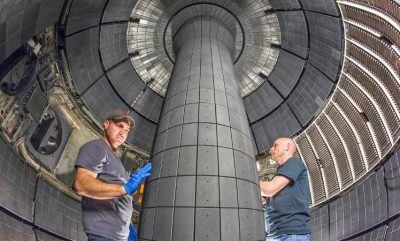
Researchers from the Princeton Plasma Physics Laboratories (PPPL) presented first results from the research on the National Spherical Torus Experiment Upgrade (NSTX-U) at the 26th International Atomic Energy Agency Conference (IAEA) in Kyoto, Japan.
The upgrade finished in May 2016 made the NSTX-U the most powerful fusion facility of its kind, since it doubled the magnetic field strength, plasma current and heating power capability of the predecessor facility. To achieve this the central stack (solenoid) was widened.
Main results and achievements of the first 10-weeks of NSTX-U operation are listed as following:
- Surpassing the maximum magnetic field strength and pulse duration of the predecessor.
- Achieving high plasma confinement, or H-mode, on just the eighth day of the 10 weeks of experiments. H-mode is a superior regime for fusion performance.
- Reducing plasma instabilities with beams from a second neutral beam injector that fired beams at different angles than the original first injector which generated the initial instabilities.
- Changing the propagation direction of other instabilities using the second neutral beam injector that provides increased flexibility in the distribution of energetic ions.
- Advancing development of methods to prevent plasma disruptions and to ramp down plasma when disruptions can no longer be avoided. Such methods will be critical for ITER and for all future tokamaks.
- Identifying and learning to correct conditions called error fields that are common to tokamaks and can hinder the performance of fusion plasmas.
- Commissioning all magnetic diagnostics needed to gauge control of the plasma and demonstrating advanced diagnosis of the surface composition of the reactor walls.
Currently researchers look forward to continuing their research, when NSTX-U repairs are finished and the spherical tokamak resumes operation.
Source: PPPL news
